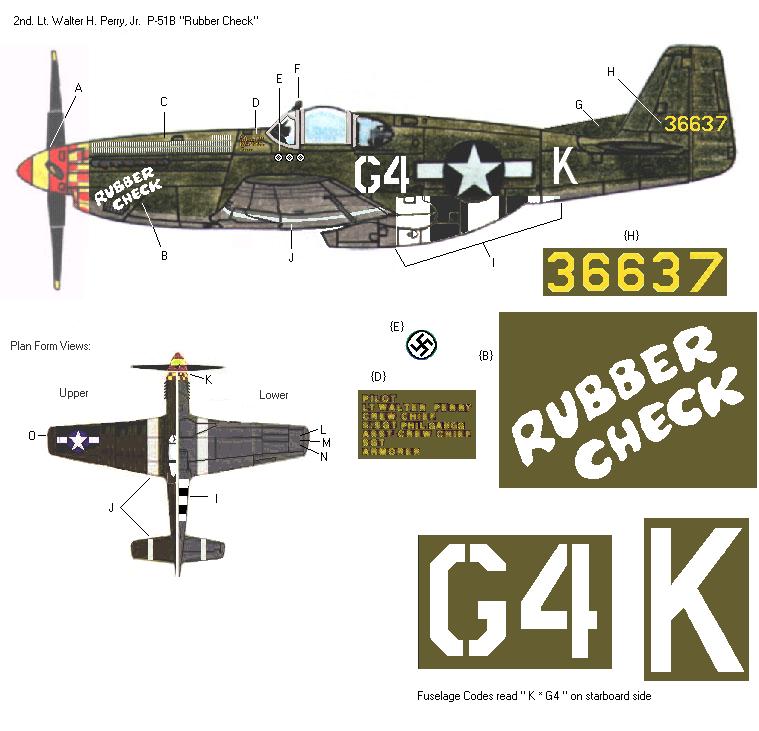357th FG Profile

2nd Lt. Walter H. Perry Jr.’s P-51B “Rubber Check”

Summer 1944
Modeler Tips:
Side View Notes:
A. Rear red band on propeller boss extends onto spinner to leading edge of blades when in neutral pitch. Determine width of yellow band by dividing remainder of spinner evenly.
B. “Rubber Check” in white balloon letters splashed over scoop and lower strip panels.
C. White tally-style mission marks- irregular in thickness and fading. Photo of aircraft on page 95 in Merle Olmstead’s book “The 357th Over Europe” shows this feature fairly well.
D. Name stencil for pilot & crew in yellow rests over fluid reservoir panel. Pilot, Crew Chief, Asst Cr Chief, and Armorer titles provided, but only the names of the pilot and crew chief were entered.
E. Kill marks- single row of 3 black swastikas on white circle bordered in black. Last one lines up with joint between the windscreen and canopy.
F. RAF-style Malcolm hood and half-sphere mirror, note irregular natural aluminum portions of canopy framing. Mirror housing and pylon was camouflage green.
G. Retrofitted vertical fin extension. From aft fuselage bulkhead to level of lower edge of rudder trim tab.
H. Tail Number in yellow- “36” on fin, “637” on rudder.
I. Reduced invasion stripes come up to tips of lower arms of stars in the insignia. Sides of radiator ventilation flap were natural metal.
J. White recognition stripes were of standard widths on vertical & horizontal stabilizers for 1944 ETO Mustangs.
Upper & Lower View Notes:
I. same as item “I”, above.
J. Same as item “J”, above.
K. Width of checker reduced on underside in order to fit evenly on the narrow surfaces of the chin scoop area. L, M, N. Red, Green, Yellow navigation lights- circular and flush with wing panel.
O. Formation Lights- Red (Port) and Green (Starboard)
Overall Modeling Tips:
*This aircraft wore dark olive green over USAAC medium gray. Project number was stenciled in black over camouflage coat. Paint on the flat camouflage colors first- then mask off appropriate portions of canopy framing and paint in natural aluminum color. Most metal colors will be marred or removed by masking materials so it’s often better to leave them for last.
*No antenna wires were installed on this aircraft. Some decal manufacturers have indicated that the mission marks only occupied the after-half of the port engine cover, but photos show that by the time Lt. Perry and his Mustang were lost in combat near Bastogne in late December 1944, the mission marks occupied the entire length of the nose in two rows and that a third row had been started- he and his aircraft had obviously over flown Occupied Europe many times.
*After building several 357th A/C over the past 30 years, I recommend painting the nose area forward of the exhaust cutout yellow when the flat features are painted. When the time for decals arrives, carefully cut away the yellow squares from the checkerboard decal and apply the remaining strip of red checkers to the nose. This method significantly reduces the potential for bubbles, and wrinkles plus it makes exact alignment of the decal easier.
*Prior to assembly, wash clear plastic parts with a mild glass cleaner and gently wipe dry. Then use a Q-Tip to evenly spread clear liquid floor wax (Future Brand seems to get the best results) on both inside & outside. Protect from dust and let dry for at least 2 hours. The wax fills in microscopic flaws and creates an even gloss that is clearer & shines brighter than the original plastic underneath.
Repli-Scale Decal Sheet 48-5056

